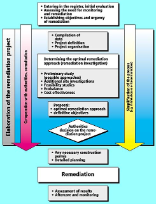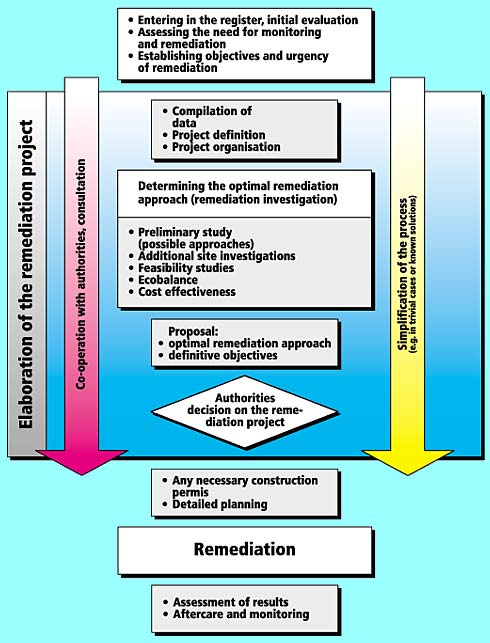The site has been remediated.
Principles of remediation:
- The objective of a remediation is to prevent the unlawful impact on the environment. A remediation is only considered completed upon achieving its objectives.
- The remediation must remove the danger over the long term and in sustainable fashion; the burden of treating seepage water should not be carried by upcoming generations.
- Remediation of a contaminated site as such should considerably reduce the danger to the environment.
- The remediation project must deliver complete and understandable decision bases for the definitive establishment of remediation objectives and deadlines.
- Appropriate information and communication is indispensible in remediating contaminated sites.
The remediation project - not a nuisance but the basis for a successful and reasonably priced remediation
An optimal and the most sustainable approach to remediation possible requires a solid foundation: That is the purpose and function of the remediation project to be worked out by the party obliged to remediate. The remediation measures, geared to the individual case - ecologically sound, technically possible and financially bearable - are to be worked out within the remediation project. The remediation project provides the authorities with an instrument with which to assess the proposed measures and to definitively establish in consultation with the affected parties the remediation objectives and measures.
But not every remediation project requires the same effort and outlay. The extent and degree of detail are a function of the complexity of the contaminated site. Particularly in the case of urgent or smaller remediation cases, or in cases with known solutions, short cuts are not ruled out. The parties involved must maintain ongoing communication in order to find a consensus so that the required measures can be established quickly and efficiently from the cost point of view e.g. in evaluating the suitable remediation possibilities. In addition, an open information policy during the remediation of a contaminated site can contribute to a cooperative climate where not every step results in a sequel in court.

Elaboration of the remediation project
What remediation measures are suitable to which cases?
As a rule, decontamination of a site is indicated where the need for remediation can be traced to persistent organic compounds or heavy metals. In many cases decontamination consists of excavating the polluted material, removing it from the site for disposal. In every case it must be clarified if separation into incinerable or recyclable material is possible.
And in any case care must be taken that off-site disposal of the polluted material takes place in accordance with the Technical Ordinance on Wastes and in accordance with the Excavation Guidelines. Biological in-situ processes as a rule only fulfil the requirement for a sustainable suppression of the source in the case of biologically easily degradable material, such as mineral oil.
Long-term effective and sustainable remediation means:
that after no more than one or two generations, the cleaned up site can be safely left to posterity without any further measures.
Securing measures are primarily appropriate where the site can be left to its own devices based on the present facts about the pollutants and due to the considerable degradation of the pollutants over the course of no more than one to two generations without any further treatment measures needed (which is the case for many landfills for household waste or mineral oil contamination, for example). In establishing securing measures for sites, attention must be paid to long-term maintenance, monitoring, overhauling and seizure of the requisite financial means. Negative environmental impact at polluted sites that have been secured can only be prevented as long as the securing measures function.
Further information
Links
-
Erstellung von Sanierungsprojekten für AltlastenAltlasten, Sanierung. 2001
-
Sicherung von Deponie-AltlastenStand der Technik, Grenzen und Möglichkeiten. 2007
-
Evaluation von SanierungsvariantenEin Modul der Vollzugshilfe «Sanierung von Altlasten». 2014
Last modification 07.07.2021






